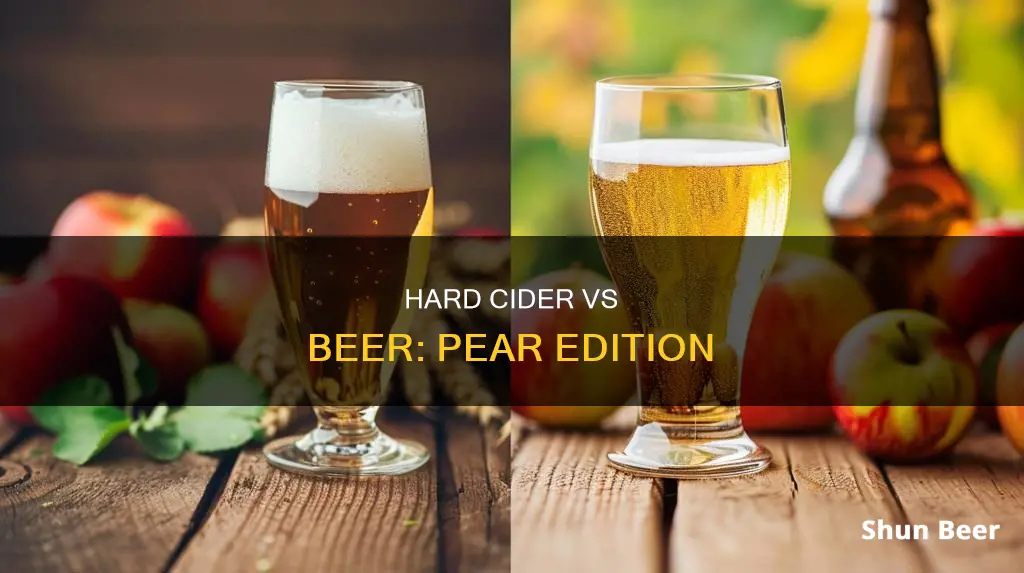
Hard cider is a type of alcoholic drink made from fermented apple juice, while beer is made from the fermentation of grain mash. The main difference between pear hard cider and beer is that pear hard cider is made from fermented pears, while beer is made from fermented grains. Pear hard cider, also known as perry, is typically made from small, bitter pears that are not suitable for eating raw. The fermentation process for perry is similar to that of apple cider, but the taste is unique, with a prominent pear aroma. Perry tends to have more residual sugar than cider due to the presence of sorbitol, a type of unfermentable sugar alcohol found in pears. In contrast, beer tends to have a bitter taste due to the use of hops and other bitter ingredients.
| Characteristics | Values |
|---|---|
| Main ingredients | Cider: Fruit juice (apples or pears) |
| Beer: Grain mash (malted barley or other cereals), hops | |
| Fermentation process | Cider: Juice is fermented using wild yeast |
| Beer: Grain mash is boiled and then fermented | |
| Alcohol content | Cider: 7-8% ABV |
| Beer: 4.5% ABV | |
| Carbonation | Cider: Can be still or sparkling |
| Beer: Always carbonated | |
| Colour | Cider: Yellow, orange, brown |
| Beer: Light amber to dark brown |
What You'll Learn

Cider is made from fruit juice, whereas beer is made from grain
Cider is defined as the (liquid) product of fermented apples. Hard cider is defined as fruit wine made from either apples or pears. With or without bubbles, other fruit wines cannot be called cider in the traditional sense.
The process of making pear cider is similar to making apple cider, but the taste is as unique as a pear itself. Cider is made from raw, unfiltered juice. Since the juice is pressed fresh, it will quickly oxidize and give that characteristic brown color we all know and love from apple cider.
Perry, or pear cider, is an alcoholic beverage made from fermented pears. The pears used to make perry are typically not the large, sweet varieties eaten as fresh fruit. Perry pears tend to be small and relatively bitter. The distinction between table pears and perry pears is similar to the difference between table apples and cider apples.
The majority of perry pear varieties in the UK originate from the counties of Gloucestershire, Herefordshire, and Worcestershire in the west of England. Perry from these counties, made from traditional recipes, now forms a European Union Protected Geographical Indication.
Compared to cider apples, perry pears have fewer volatile components and consequently fewer aromatics in the finished product. Their tannin profile is very different, with a predominance of astringent over bitter flavors. They do, however, contain a high concentration of esters that give them their prominent pear aroma.
Another important attribute of perry pears is their relatively higher content ratio of sorbitol to other sugars, such as fructose. Because sorbitol is not readily fermented by yeast, it is not converted to ethanol, so perry tends to have more residual sugar than cider produced from the fermentation of apples. In addition, sorbitol also contributes to increased body and a softer mouthfeel in the finished perry.
Cider vs Beer: What Sets Them Apart?
You may want to see also

Cider is defined as the product of fermented apples
Cider is a fermented alcoholic beverage made from the juice of apples. The process of making cider involves crushing and pressing apples to extract their juice, which is then fermented using yeast. This process can be done at home or on a commercial scale, and the type of apples used, as well as the specific steps involved, can vary depending on the desired style and quality of the final product.
The history of cider dates back thousands of years, with ancient writings mentioning alcoholic beverages made from apples or pears. Today, cider is produced and consumed worldwide, with notable production in Europe, North America, South America, Asia, Africa, Australia, and New Zealand. The term "cider" can refer to both the alcoholic beverage and unfiltered, unpasteurized apple juice, depending on the region.
The taste and characteristics of cider depend on various factors, including the type of apples used, the fermentation process, and any additives or sweeteners. Cider can range from dry to sweet, and it can be still or carbonated. Some common commercial ciders are mass-produced and resemble sparkling wine, while traditional ciders tend to be darker, cloudier, and stronger in apple flavor.
In summary, cider is a versatile and globally enjoyed beverage with a long history and a wide range of styles and flavors.
Beer's Reaction to Containers: A Study
You may want to see also

Beer brewing is an ancient process, dating back to 3,900 BC
The earliest archaeological evidence of fermentation consists of 13,000-year-old residues of a beer used by the semi-nomadic Natufians for ritual feasting. Beer residue was also discovered on 5,000-year-old pottery in China, and ancient pottery jars in Iran indicate that beer was produced there around 3,500 BCE.
The process by which beer was discovered is a matter of debate. One theory suggests that it was an accidental discovery when grains were soaked in water, creating a porridge or gruel. Ancient peoples would heat the gruel and leave it throughout the day. The gruel would undergo spontaneous fermentation due to wild yeasts in the air, and ancient people would notice the change in taste and its effects.
Beer brewing was, for the most part, a household project carried out by women. It was a common task in ancient Mesopotamia, and brewing was a fairly well-respected occupation. Brewing was also a household task in Neolithic Europe, where beer was likely brewed as early as 5,000 years ago.
The ancient Egyptians provided their labourers with a daily ration of four loaves of bread and two jugs of beer. Beer was also used in religious practices, and during the construction of the Great Pyramids of Giza, each worker was given a daily ration of four to five litres of beer.
The ancient Greeks and Romans, however, preferred wine as they lived in a climate where grapevines flourished. Brewing continued as a household task during the Dark Ages and was carried out in monasteries during the Middle Ages, serving not only the monks but also pilgrims and surrounding villages.
In the late Middle Ages, brewing began to move from a family-oriented activity to an artisan one, with pubs and monasteries brewing beer for mass consumption. The key innovation was the introduction of hops, which began in northern Germany in the 13th century. Hops improved both the brewing process and the quality of beer, giving it a flavour closer to that of contemporary beer.
Today, the brewing industry is a global business, consisting of several multinational companies and thousands of smaller producers. Advances in refrigeration, international shipping, marketing, and commerce have resulted in an international marketplace, where consumers have a wide variety of choices.
Heineken's Unique Brewing Process: What Sets it Apart?
You may want to see also

Cider is gluten-free, whereas beer is not
In contrast, beer is a gluten-containing drink, as it is brewed from grains such as wheat, barley, and rye. For those with coeliac disease or a gluten sensitivity, drinking beer can trigger symptoms such as diarrhoea, stomach pains, and lethargy.
While most ciders are gluten-free, it is important to note that some ciders may contain trace amounts of gluten due to the use of gluten-based yeast in the fermentation process. Therefore, it is always worth checking the label to ensure the cider is gluten-free, especially if you have a gluten intolerance or coeliac disease.
Sour Beers: A Unique Fermentation Process
You may want to see also

Cider is often allowed to ferment longer than beer
However, due to the different apple and grain types, the variation in alcohol content overlaps quite a lot. There are beers with higher alcohol contents, such as Belgian-style beers, and there are also stronger ciders of up to 15%, but these are not common and are more often referred to as apple wines or ice cider.
The fermentation process of cider will complete the transition into becoming an alcoholic beverage all by itself. Ale, on the other hand, must be prepared by heating a mash to start converting the grains into sugars. Once this is completed, the sugars that come from grains will react with the yeast and slowly convert them into alcohol.
Cider is also often frozen to create the stronger ice cider or applejack. This concentration of alcohol and flavours is usually not done with beer, and longer fermentations with added sugar can typically ruin the flavours of beer but often do okay with cider.
The process of making cider is, therefore, much simpler and more straightforward than that of beer. Cider is also often regarded as tasting better than beer because beer is inherently bitter and less sweet in its taste. However, this is strongly subjective, and some people love the sour complex taste of cider, while others love the bitterness of beer.
Vodka vs Beer: Different Drunk Feels
You may want to see also
Frequently asked questions
Pear cider is made from fermented pears, while beer is made from the fermentation of grain mash.
Pear cider is a refreshing drink made from pears. It can be sweet or hard. Sweet pear cider is a mixture of pear and apple juices mulled in a crockpot with cinnamon sticks, ginger, and maybe allspice. Hard pear cider, also known as perry, is a gluten-free alcoholic drink with very little alcohol.
To make pear cider, you need to crush and press the pears to extract the juice. Then, you can add various ingredients like sugar, honey, or spices to taste. Finally, the juice is fermented using yeast, and the cider is ready to drink!







